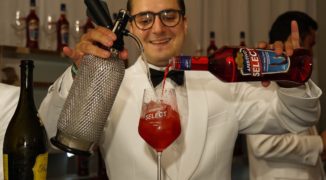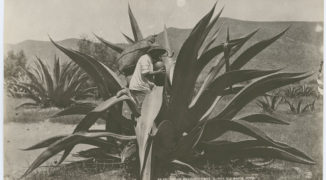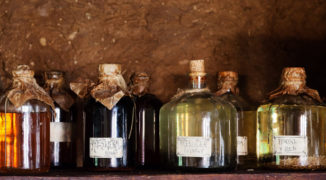“Wassail, wassail, all over the town
Our toast it is white and our ale it is brown
Our bowl it is made of the white maple tree
With the wassailing bowl we’ll drink to thee”
— Gloucestershire Wassail Carol
When you read the lyrics aloud to this drinking song (or hear the tune), you can almost feel that cup of hot alcohol in your hand as you drunkenly sway to and fro, singing at the top of your lungs around the Christmas tree. The drink, wassail, conjures images of caroling revelers dressed in boughs of holly and fir with wooden crocks full of good cheer in a Bacchus-type parade through city streets. It’s nostalgia wrapped in a warm blanket of cider, mulled wine, nutmeg and floating orange slices. A celebratory holiday gathering around a highly decorative punch bowl. But, wassail has a muddled heritage. Is it warm booze? An action verb? A hearty salutation? A song? Yes. It’s all of these things, and it includes a storied family tree rooted in tradition and branching out in nearly every direction for over a millennium.
I salute thee…Waes hael!
First, let’s rewind to a castle in 5th-century Britain, where Rowena — the beautiful daughter of a Saxon leader — seduces an incredibly inebriated King Vortigern with a goblet of spiced wine, giving the first recorded toast in history to his good health by crying out, “Waes hael!” Taken by her beauty, he immediately beds then weds the girl after ordering her to drink of the same cup and exclaiming, “Drinc hael!” — “drink, and good health!” This moment in British history becomes the foundation on which one thousand years of wassail tradition spring forth and is said to be the first documented “toast” in history. Seems legit, right?
Whether we are to believe a drunken king wearing wine goggles is charmed into bed, then marriage by a potion-bearing, Saxon babe — thus inadvertently setting the course of the Western world’s drinking culture — is neither here nor there. The point is, it’s a great story. One of many attributed to the history and lore which seem to surround wassail. No one really knows what was in that goblet. Was it spiced wine? Mead? Ale? It doesn’t matter. Wassail was not a drink that night. It was simply a salutation — a toast among drinking buddies celebrating the good health of their friend, the king. Whatever the case, the salute stuck. The word as we know it today, “wassail,” first appears in the 8th century poem “Beowulf”. In the poem, it is again not a drink, but a salute to its warriors.
“Forlorn he looks on the lodge of his son,
wine-hall waste and wind-swept chambers
reft of revel. The rider sleepeth,
the hero, far-hidden; no harp resounds,
in courts no wassail, as once was heard.”
Get wassailed
“I’ve always liked the fact that wassail produced a verb — wassailing, which suggests roots in social activity — something arising out of the dark, northern days of the holiday season. I’ve heard people talk about going cocktailing, but that doesn’t have the same ring.”
-Wayne Curtis, author of And a Bottle of Rum: A History of the New World in Ten Cocktails
Long after Vortigern and Rowena’s intoxicating meeting, wassail continued to dominate English drinking culture in one form or another. The act of “wassailing” dates back to pre-Christian times when farmers living in England’s southeastern apple-growing region would gather in the mid-winter chill in the orchards collectively shouting while pouring cider onto their trees to ward off evil spirits. By wassailing their crops in the winter, it was said to ensure a healthy crop in the spring. As Christianity began to spread, this ritual evolved further into singing and drinking to the health of next season’s crops on Twelfth Night; the last night of the traditional Christmas season. It seemed only appropriate to attach the celebration of Christ’s birth and his visit from three wisemen with the hope for a good yield in the orchards in the coming year. It also assured them not being burned as heretics under the ever-watchful eye of the Church.
In some regions of medieval Britain, wassail involved a large gathering of tenants at the manor house where the master, channeling Rowena, would hold up a bowl of steaming spiced wine or ale and shout, “Wassail!” with the crowd replying, “Drink hail!” before devolving into Christmas revelry. Yet in other regions, wassailing took on a slightly sinister tone with drunken crowds gathering outside feudal lords’ homes while bowls of ale flowed, singing loudly and not dispersing until they received Christmas treats. Hence the line in We Wish You a Merry Christmas, “Now give us a figgy pudding. We won’t go until we get some.” You can imagine the fear of the manors’ inhabitants watching a fire, backlit crowd of drunken idiots demanding food growing larger and louder by the minute. That’s enough to make anyone relent to mob rule.
In the 14th century, someone decided to morph the old story of King Vortigern and Rowena, their boozy salute, and the passing of the loving cup yet again. This time, the act of door-to-door drinking took a cue from the simple act of saluting and celebrating to a healthy, happy new year. Crowds of carolers would visit neighbors rather than their masters with a large wassailing bowl filled with a spiced punch of mulled wine or ale, nutmeg and sugar. People would then dip toasted bread into the mixture to soak up the flavor and share in the merriment. This band of intoxicated carousers unwittingly created our modern word to “toast” by simply floating a few croutons in a bowl of ale. But it was from here, the act of wassailing and its drink would forever merge, forming one of cocktail’s most enduring partnerships.
Wassail, wassail!
By the Renaissance, wassailing had a firm foothold in England’s Christmas traditions. The drunken band of rabble-rousers banging on doors begging for figgy pudding was now simply spreading good cheer door-to-door in the village while singing Christmas carols with a punch bowl of sweetened, spiced ale. But it was during the 17th century the liquid inside the bowl finally started to take center stage in the merry ritual of Christmas and its now 500-year love affair with apples. The rich punch-like mixture called “Lambswool” was considered the wassail drink of choice for the Christmas punch bowl of the day. It contained warm ale or mulled wine, sugar, nutmeg, eggs, toasts, and “crabs” — steaming, roasted crab apples dropped still-hot into the warm punch, bursting upon impact and making a hissing sound as the mixture frothed and bubbled. The crabs gave the punch a tart sweetness while adding a bit of drama. It is from Lambswool that what we know as the traditional Christmas wassail drink was birthed.
From wassail to nog to toddy
What started as most likely mead or spiced wine sweetened with honey has gone through many transformations throughout the centuries. Wassail evolved from a hot punch-like beverage of mulled wine spiced with nutmeg and raisins to keep the winter chill at bay for loitering merrymakers to its modern Christmas cousin, the cider concoction containing wine, bobbed apples, and sliced oranges and in some households, to an even richer, cream-based punch containing sherry, crusts of bread or sweet cakes, and even eggs.
As the punch matured, mixtures of madeira, sherry, or brandy began to appear alongside the the traditional ale or cider, becoming a modern, more complex split based punch. When settlers began arriving in America, “wassailing” had become nothing more than a celebratory gathering at home with friends during Christmas with a cider-based punch spiked with rum. An ocean now separated the old and new. Wassail’s American transformation continued as generations grew further from their English roots, streamlining the creamy Lambswool-based punches into egg nog or the cider-rum mixtures into a wassail-for-one with the whiskey-forward hot toddy. It is these drinks we now most associate with our modern holiday traditions as the punch bowl of yore gathers dust on the shelf in the China cabinet.
The carousing traditions of wassail may have gotten lost in its own convoluted history, but the drink that emerged from the lore continues to play a small role in the nostalgia that is Christmas in the Western world. Many still gather around the punch bowl, sometimes singing carols, often happily sipping a cider-based, spiced concoction which today may or may not contain alcohol. Even the vessel has modernized, with wassail being kept warm for party-goers’ convenience in the crock pot; always at the ready for ladling into a punch cup.
Wassail is indeed both a noun and a verb. Mostly it is a salutatory celebration of a long year as you gather with those you cherish and raise a glass of good cheer to toast to a healthy, happy new year and enduring friendships. For wassail is, first and foremost, a salute.
So, we say to you, TOTCF readers, whatever you believe, “Wassail! Drink hail!”





